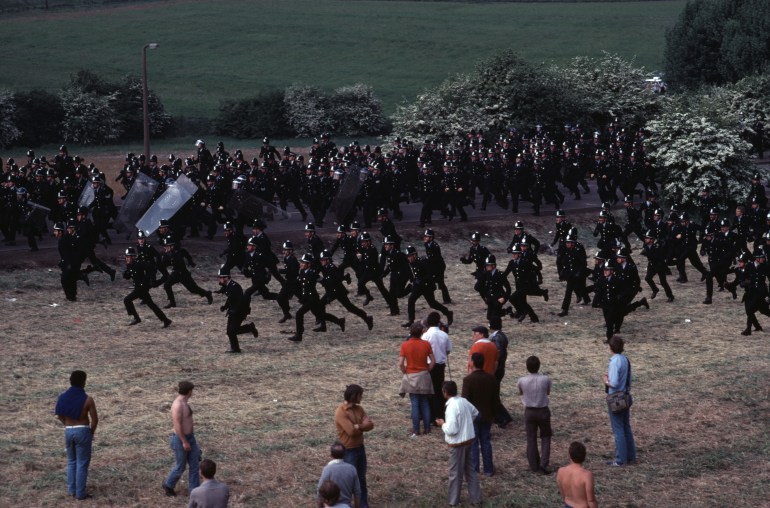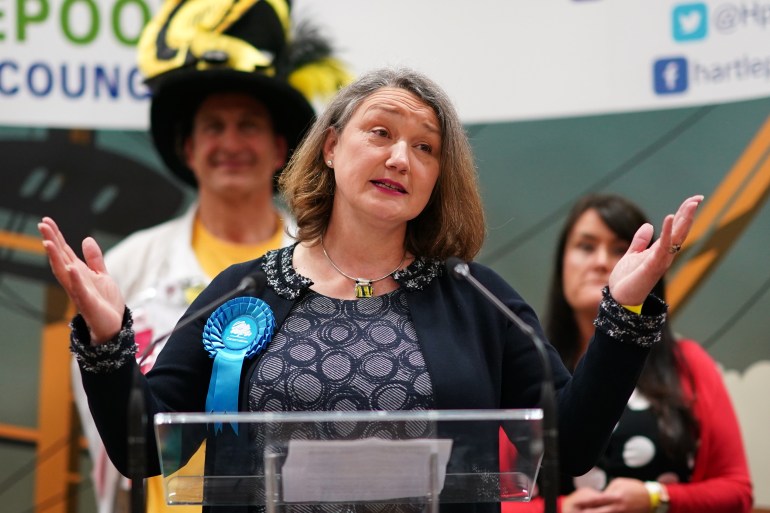On 40th anniversary of UK miners’ strike, can Labour win back the north?
What caused the miners’ strike 40 years ago and why did ‘Red Wall’ communities turn against Labour in the last election?

It divided communities, split families and changed the face of a nation.
The 1984-85 United Kingdom miner’s strike, which kicked off 40 years ago this week, was an epoch-defining event in the social history of Britain as thousands of coal miners left their pits in protest against Conservative Prime Minister Margaret Thatcher’s drive to close collieries across northern England.
Keep reading
list of 4 itemsColumbia University’s Shafik rebuked over Gaza crackdown but avoids censure
US returns ancient artefacts looted from Cambodia, Indonesia
Scottish First Minister Yousaf promises to fight no-confidence vote
A year-long struggle would lead to the arrest of more than 11,000 miners and would cement Thatcher’s status as a hate figure among trade unionists and supporters of the left.
Five years ago, however, many of these former mining heartlands, once solidly of the Labour left, voted for the right-wing Conservative Party in droves, propelling then-UK Prime Minister Boris Johnson to comprehensive victory in the 2019 British general election.
The so-called “Red Wall” – 45 constituencies in northern England and the English Midlands which had been held by Labour for generations – turned Conservative blue leading to Labour’s worst election result since 1935.
But as Britain braces itself for the likelihood of another general election later this year, the opposition Labour Party is eyeing a return to power. And crucial to its success will be winning back those former mining towns, which, 40 years ago, were at the heart of one of the most acrimonious industrial disputes in British history.
How did the miners’ strike unfold?
On March 6, 1984, the National Coal Board (NCB) announced its intention to close 20 pits which it deemed unprofitable, spelling the loss of some 20,000 jobs. The decision was supported by Thatcher who wanted to break the power of the trade unions and privatise an industry which was heavily subsidised by the government.
About three-quarters of Britain’s 187,000 miners protested after the National Union of Mineworkers (NUM), led by firebrand socialist Arthur Scargill, called a general strike on March 12.
But Scargill’s decision not to ballot his members on the issue of industrial action – out of concern that he might lose – meant that the NUM’s stance lacked political legitimacy, say experts.
Picketing miners in England – as well as Scotland and Wales – clashed with police, at times violently, and feuded with non-striking colleagues, many of whom were labelled “scabs” (traitors) and ostracised by their communities as a result.
In the end, the striking miners, facing financial hardship due to loss of earnings, were forced to back down and return to the pits.

How did the mine closures affect northern communities?
The beaten British miners returned to work in March 1985, but Thatcher’s bid to close mines her government deemed unprofitable continued during her premiership. (The UK’s last deep coal mine, in North Yorkshire, shut in December 2015.)
But communities in northern England and elsewhere were “decimated” by Thatcher’s pit closures, say left-wing politicians and residents.
Labour Party MP Ian Lavery was a 21-year-old miner in the northern English region of Northumberland in 1984. This week he told local paper the Northumberland Gazette that areas affected by mining closures still bear the scars of “poverty” due to the actions of Thatcher’s Conservative government.
Today, many ex-miners are thought to have died destitute as a result of the 1994 Mineworkers’ Pension Scheme agreement, which, claim campaigners, has seen successive UK governments take 50 percent of the ex-mineworkers’ surplus pension funds in return for a pledge that the fund’s value would not fall.
Why did former English mining towns vote for the Conservatives in 2019?
Areas of the north Midlands and northern England were once referred to as the “Red Wall” because they consistently voted for Labour. However, this changed in 2019 when many of them “turned blue” and voted Conservative – often for the first time ever.
Britain’s departure from the European Union in 2020 following its majority Leave vote in the Brexit referendum four years earlier is cited as one reason these former Labour strongholds turned their backs on the opposition.
Many former mining towns in the Red Wall had been in favour of Brexit. Professor Huw Beynon, co-author of The Shadow of the Mine: Coal and the End of Industrial Britain, told Al Jazeera that these areas had returned pro-Brexit majorities in the 2016 referendum because they “once saw themselves at the centre of an economy based on coal mining and steel [and] reacted to being pushed to the sidelines and ignored”.
He added: “There was anger linked to a loss of hope which was played upon in the campaign for Brexit, identifying the EU as a cause of all the changes.”
For example, Bishop Auckland, a former mining town in northeast England, voted in a Conservative MP for the first time ever.
According to reports at the time, Conservative leader Boris Johnson’s “Get Brexit Done” mantra in the leadup to the election resonated with many of these longtime Labour-supporting Leavers. As commentator Heather Parry wrote in the Big Issue magazine of December 2019, workers there felt “patronised and ignored, as if their vote in 2016 was being disregarded” by a Labour leadership which, by contrast, had pledged to hold a second Brexit vote if elected to government.
This sentiment continued after 2019. In a 2021 by-election, Labour stronghold Hartlepool, a coastal town close to the former Blackhall colliery in northern England, turned blue when the incumbent who had held the seat for Labour since 1974 was removed in a by-election in favour of Conservative Jill Mortimer.

Can Labour win back its old mining heartlands at the next election?
The UK must hold another general election by January 2025, and is expected to do so later this year.
Recent analysis from global polling firm Redfield & Wilton Strategies suggests that the Labour Party has a commanding lead over the Conservatives in the Red Wall seats, which include the Thatcher-hating mining towns, and enjoys a roughly 20-point lead over the Conservative Party across the country.
James Mitchell, a professor at the University of Edinburgh’s School of Social and Political Science, told Al Jazeera that “while many in these [Red Wall] seats have not yet been converted into Remainers or Rejoiners, many are aware that Brexit has not delivered” the rise in living standards which, he said, “had been promised” by pro-Brexit political leaders.
He added: “Voters in these seats will be well aware of the pain of the cost-of-living crisis. We may well look back and see this [2019] period when the Red Wall collapsed as an aberration.”
But Beynon added: “Political thinking in these places is now characterised by scepticism and mistrust. They are likely to turn their backs on the Conservatives next time, but it won’t be a return to the Labour fold as of old. Trust has been lost and won’t easily be regained.”